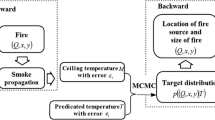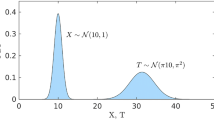Abstract
Towards the development of a more rigorous approach for coupling collected fire scene data to computational tools, a Bayesian computational strategy is presented in this work. The Bayesian inversion technique is exercised on synthetic, time-integrated data to invert for the location, size, and time-to-peak of an unknown fire using two well-known forward models; Consolidated Model of Fire and Smoke Transport (CFAST) and Fire Dynamics Simulator (FDS). A Gaussian process surrogate model was fit to coarse FDS simulations to facilitate Markov Chain Monte Carlo sampling. The inversion framework was able to predict the total energy release by all fire cases except for one CFAST forward model, a 1000 kW steady fire. It was found that insufficient information was available in the time-integrated data to distinguish the temporal variations in peak times. FDS performed better than CFAST in predicting the maximum energy release rate with the posterior mean of the best configurations being 0.05% and 2.77% of the true values respectively. Both models performed equally well on locating the fire in a compartment.











Similar content being viewed by others
References
De Haan JD (2008) Kirk’s fire investigation. Pearson/Brady
Hicks W, Gorbett GE, Kennedy PM, Hopkins RL, Abney WM (2006) Advanced fire pattern research project: single fuel package fire pattern study. In: 2006 International symposium on fire investigation proceedings, National Association of Fire Investigators, Sarasota, FL
Hicks W, Gorbett GE, Hopkins MC, Kennedy PM, Hopkins RL, Thurman JT (2008) Full-scale single fuel package fire pattern study. In: 2008 International symposium on fire investigation proceedings, National Association of Fire Investigators, Sarasota, FL
Madrzykowski D, Fleischmann C (2012) Fire pattern repeatability: a study in uncertainty. J Test Eval 40(1):1
Yeager RW (1986) Uncertainty analysis of energy release rate measurement for room fires. J Fire Sci 4(4):276–296
Madrzykowski D (2017) Repeatability of pre-flashover fire patterns on gypsum wallboard. Ph.D thesis, University of Canterbury
Mealy CL, Wolfe AJ, Gottuk DT (2013) Forensic analysis of ignitable liquid fuel fires in buildings. Hughes Associates, Incorporated
Farrell MG (2012) Daubert v. merrell dow pharmaceuticals Inc.: epistemilogy and legal process. Cardozo Law Rev 15(6):2183–2218
National Research Council (2009) Strengthening forensic science in the united states: a path forward. Technical report, National Research Council
Lentini J, Mowrer F, Pawliszyn J, Almirall J, Arkes H (2017) Forensic science assessments: a quality and gap analysis. Technical report
Nordgaard A, Hedell R, Ansell R (2011) Assessment of forensic findings when alternative explanations have different likelihoods—“blame-the-brother”-syndrome. Sci Justice 52:226–236
Wang J, Zabaras N (2004) A bayesian inference approach to the inverse heat conduction problem. Int J Heat Mass Transf 47:3927–3941
Biedermann A, Taroni F, Delemont O, Semadeni C, Davison AC (2005) The evaluation of evidence in the forensic investigation of fire incidents (part I): an approach using bayesian networks. Forensic Sci Int 147(1):49–57
Biedermann A, Taroni F, Delemont O, Semadeni C, Davison AC (2005) The evaluation of evidence in the forensic investigation of fire incidents. part II. Practical examples of the use of bayesian networks. Forensic Sci Int 147(1):59–69
Guo S, Yang R, Zhang H, Zhang X (2010) New inverse model for detecting fire-source location and intensity. J Thermophys Heat Transf 24(4):745
Overholt KJ, Ezekoye OA (2012) Characterizing heat release rates using an inverse fire modeling technique. Fire Technol 48:893–909
Overholt KJ (2013) Forward and inverse modeling of fire physics towards fire scene reconstructions. PhD Dissertation, University of Texas at Austin. http://hdl.handle.net/2152/21971
Overholt KJ, Ezekoye OA (2014) Quantitative testing of fire scenario hypotheses: a bayesian inference approach. Fire Technol 51(2):335–367
Patil A, Huard D, Fonnesbeck CJ (2010) PyMC: Bayesian stochastic modelling in Python. J Stat Softw 35(4):1
Bolstad WM (2010) Understanding computational Bayesian statistics, vol 644. John Wiley & Sons
Powell MJD (1964) An efficient method for finding the minimum of a function of several variables without calculating derivatives. Comput J 7(2):155–162
Roberts GO, Rosenthal JS (2009) Examples of adaptive MCMC. J Comput Graph Stat 18(2):349–367
Geweke J (1991) Evaluating the accuracy of sampling-based approaches to the calculation of posterior moments, vol 196. Federal Reserve Bank of Minneapolis, Research Department, Minneapolis, MN
McGrattan K, Hostikka S, McDermott R, Floyd J, Weinschenk C, Overholt K (2013) Fire dynamics simulator, technical reference guide, vol 2: verification. NIST Special Publication, 1018-2
McGrattan K, Hostikka S, McDermott R, Floyd J, Weinschenk C, Overholt K (2013) Fire dynamics simulator, technical reference guide, vol 3: validation. NIST Special Publication, 1018-3
Babrauskas V (2002) SFPE handbook of fire protection engineering, chapter heat release rates, 3rd edn. National Fire Protection Association, Quincy
Nelder JA, Mead R (1965) A simplex method for function minimization. Comput J 7(4):308–313
Gorbett GE, Meacham BJ, Wood CB, Dembsey NA (2015) Use of damage in fire investigation: a review of fire patterns analysis, research and future direction. Fire Sci Rev 4(1):4
O’Hagan A (1978) Curve fitting and optimal design for prediction. J R Stat Soc: Ser B (Methodological) 40(1):1–24
Sacks J, Welch WJ, Mitchell TJ, Wynn HP (1989) Design and analysis of computer experiments. Stat Sci 4(4):409–423
Higdon D, Nakhleh C, Gattiker J, Williams B (2008) A bayesian calibration approach to the thermal problem. Comput Methods Appl Mech Eng 197(29):2431–2441
Rasmussen CE, Williams CKI (2006) Gaussian processes for machine learning. MIT Press, Cambridge
Kokel P, Weinschenk C, Ezekoye OA (2010) Evaluation of directional flame thermometer for real-time inversion of heat flux. In: 2010 14th International heat transfer conference. American Society of Mechanical Engineers, pp 83–92
Chen M-H, Shao Q-M (1999) Monte Carlo estimation of Bayesian credible and HPD intervals. J Comput Graph Stat 8(1):69–92
Kennedy MC, O’Hagan A (2001) Bayesian calibration of computer models. J R Stat Soc: Ser B (Statistical Methodology) 63(3):425–464
Higdon D, Gattiker J, Williams B, Rightley M (2008) Computer model calibration using high-dimensional output. J Am Stat Assoc 103(482):570–583
Acknowledgements
This work was supported by the U.S. National Science Foundation under grant number 1707090.
Author information
Authors and Affiliations
Corresponding author
Additional information
Publisher's Note
Springer Nature remains neutral with regard to jurisdictional claims in published maps and institutional affiliations.
Rights and permissions
About this article
Cite this article
Kurzawski, A., Cabrera, JM. & Ezekoye, O.A. Model Considerations for Fire Scene Reconstruction Using a Bayesian Framework. Fire Technol 56, 445–467 (2020). https://doi.org/10.1007/s10694-019-00886-w
Received:
Accepted:
Published:
Issue Date:
DOI: https://doi.org/10.1007/s10694-019-00886-w




